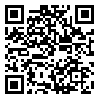Volume 78, Issue 2 (May 2020)
Tehran Univ Med J 2020, 78(2): 80-87 |
Back to browse issues page
Download citation:
BibTeX | RIS | EndNote | Medlars | ProCite | Reference Manager | RefWorks
Send citation to:



BibTeX | RIS | EndNote | Medlars | ProCite | Reference Manager | RefWorks
Send citation to:
Nasimi F, Zeraati H, Shahinfar J, Safdari M, Esmaeili A, Ghorbanzadeh M. Effect of multi-sensory stimulation on physiological parameters in preterm infants: randomized clinical trial. Tehran Univ Med J 2020; 78 (2) :80-87
URL: http://tumj.tums.ac.ir/article-1-10378-en.html
URL: http://tumj.tums.ac.ir/article-1-10378-en.html
Fatemeh Nasimi1 
 , Hossein Zeraati *
, Hossein Zeraati * 
 2, Javad Shahinfar3
2, Javad Shahinfar3 
 , Mohammadreza Safdari4
, Mohammadreza Safdari4 
 , Ali Esmaeili4
, Ali Esmaeili4 
 , Maryam Ghorbanzadeh3
, Maryam Ghorbanzadeh3 


 , Hossein Zeraati *
, Hossein Zeraati * 
 2, Javad Shahinfar3
2, Javad Shahinfar3 
 , Mohammadreza Safdari4
, Mohammadreza Safdari4 
 , Ali Esmaeili4
, Ali Esmaeili4 
 , Maryam Ghorbanzadeh3
, Maryam Ghorbanzadeh3 

1- Department of Nursing, Faculty of Nursing and Midwifery, Jahrom University of Medical Sciences, Jahrom, Iran.
2- Department of Anesthesiology, Faculty of Nursing, North Khorasan University of Medical Sciences, Bojnurd, Iran. ,zeraatih@gmail.com
3- Department of Anesthesiology, Faculty of Nursing, North Khorasan University of Medical Sciences, Bojnurd, Iran.
4- Department of Surgery, Faculty of Medicine, North Khorasan University of Medical Sciences, Bojnurd, Iran.
2- Department of Anesthesiology, Faculty of Nursing, North Khorasan University of Medical Sciences, Bojnurd, Iran. ,
3- Department of Anesthesiology, Faculty of Nursing, North Khorasan University of Medical Sciences, Bojnurd, Iran.
4- Department of Surgery, Faculty of Medicine, North Khorasan University of Medical Sciences, Bojnurd, Iran.
Abstract: (3101 Views)
Background: Premature infants undergo a lot of stressors during treatment procedures in the neonatal intensive care units which causes significant physiological changes in these neonates. Multi-sensory stimulation is a broad category of interventions designed to improve the evolutionary and physiological outcomes of premature infants hospitalized in the neonatal intensive care unit to minimize stress in this environment. So, the study aimed to evaluate the effect of multi-sensory stimulation on physiological parameters in preterm infants.
Methods: This double-blind clinical trial conducted in the neonatal intensive care unit of Shahid Motahari Hospital in Jahrom from April to December 2016. In this study, 80 preterm infants with a gestational age of 34 to 36 weeks were selected by non-probability sampling method and were randomly divided into two groups of multi-sensory stimulation and control. Neonates in the intervention group received a multi-sensory stimulation program for 60 minute. The multi-sensory stimulation program was included a combination of auditory, tactile, motor and visual stimulation. The preterm infants in the control group received only usual care. The data collecting tool was a questionnaire and checklist for physiological parameters of preterm infants.
Results: The results showed that the two groups were homogeneous in terms of fetal age, birth weight, the height of birth, first and fifth minute Apgar score of birth. The results showed that there was no significant difference between the mean of physiological indexes in the two groups before the intervention. Statistical tests showed that there was a decreasing trend in the average of all physiological indices during the intervention (first and second half during the intervention) (P<0.001), However, these changes were not significant in the control group (P<0.05). Also, analysis of variance (ANOVA) with repeated measures showed that there was a significant difference between changes in physiological variables between the two groups at different stages of evaluation (P<0.001).
Conclusion: Multi-sensory stimulation leads to a decrease in heart rate and respiratory rate and the stability of blood pressure in preterm infants.
Methods: This double-blind clinical trial conducted in the neonatal intensive care unit of Shahid Motahari Hospital in Jahrom from April to December 2016. In this study, 80 preterm infants with a gestational age of 34 to 36 weeks were selected by non-probability sampling method and were randomly divided into two groups of multi-sensory stimulation and control. Neonates in the intervention group received a multi-sensory stimulation program for 60 minute. The multi-sensory stimulation program was included a combination of auditory, tactile, motor and visual stimulation. The preterm infants in the control group received only usual care. The data collecting tool was a questionnaire and checklist for physiological parameters of preterm infants.
Results: The results showed that the two groups were homogeneous in terms of fetal age, birth weight, the height of birth, first and fifth minute Apgar score of birth. The results showed that there was no significant difference between the mean of physiological indexes in the two groups before the intervention. Statistical tests showed that there was a decreasing trend in the average of all physiological indices during the intervention (first and second half during the intervention) (P<0.001), However, these changes were not significant in the control group (P<0.05). Also, analysis of variance (ANOVA) with repeated measures showed that there was a significant difference between changes in physiological variables between the two groups at different stages of evaluation (P<0.001).
Conclusion: Multi-sensory stimulation leads to a decrease in heart rate and respiratory rate and the stability of blood pressure in preterm infants.
Keywords: acoustic stimulation, blood pressure, clinical trial, heart rate, physical stimulation, premature infant, respiration
Type of Study: Original Article |
Send email to the article author
| Rights and permissions | |
 |
This work is licensed under a Creative Commons Attribution-NonCommercial 4.0 International License. |



